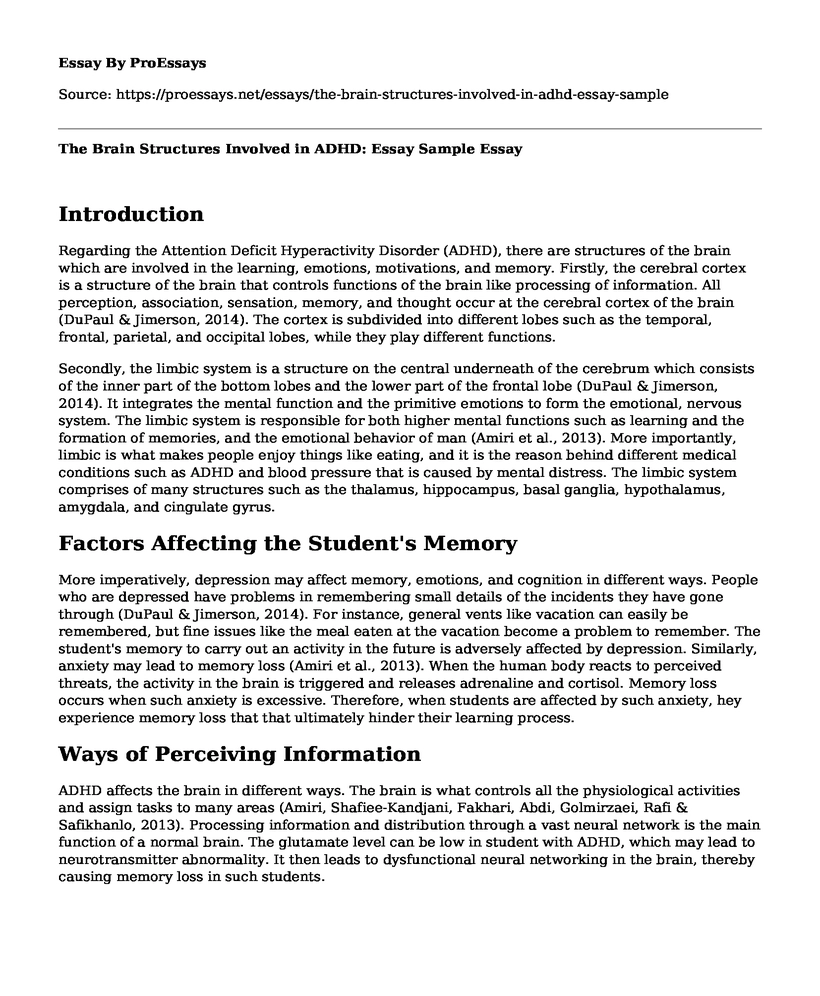Introduction
Regarding the Attention Deficit Hyperactivity Disorder (ADHD), there are structures of the brain which are involved in the learning, emotions, motivations, and memory. Firstly, the cerebral cortex is a structure of the brain that controls functions of the brain like processing of information. All perception, association, sensation, memory, and thought occur at the cerebral cortex of the brain (DuPaul & Jimerson, 2014). The cortex is subdivided into different lobes such as the temporal, frontal, parietal, and occipital lobes, while they play different functions.
Secondly, the limbic system is a structure on the central underneath of the cerebrum which consists of the inner part of the bottom lobes and the lower part of the frontal lobe (DuPaul & Jimerson, 2014). It integrates the mental function and the primitive emotions to form the emotional, nervous system. The limbic system is responsible for both higher mental functions such as learning and the formation of memories, and the emotional behavior of man (Amiri et al., 2013). More importantly, limbic is what makes people enjoy things like eating, and it is the reason behind different medical conditions such as ADHD and blood pressure that is caused by mental distress. The limbic system comprises of many structures such as the thalamus, hippocampus, basal ganglia, hypothalamus, amygdala, and cingulate gyrus.
Factors Affecting the Student's Memory
More imperatively, depression may affect memory, emotions, and cognition in different ways. People who are depressed have problems in remembering small details of the incidents they have gone through (DuPaul & Jimerson, 2014). For instance, general vents like vacation can easily be remembered, but fine issues like the meal eaten at the vacation become a problem to remember. The student's memory to carry out an activity in the future is adversely affected by depression. Similarly, anxiety may lead to memory loss (Amiri et al., 2013). When the human body reacts to perceived threats, the activity in the brain is triggered and releases adrenaline and cortisol. Memory loss occurs when such anxiety is excessive. Therefore, when students are affected by such anxiety, hey experience memory loss that that ultimately hinder their learning process.
Ways of Perceiving Information
ADHD affects the brain in different ways. The brain is what controls all the physiological activities and assign tasks to many areas (Amiri, Shafiee-Kandjani, Fakhari, Abdi, Golmirzaei, Rafi & Safikhanlo, 2013). Processing information and distribution through a vast neural network is the main function of a normal brain. The glutamate level can be low in student with ADHD, which may lead to neurotransmitter abnormality. It then leads to dysfunctional neural networking in the brain, thereby causing memory loss in such students.
Suggestions to Improve Performance
Improving performance in class can only be through memory boost. The student needs to have a proper sleep, maybe ten or twelve hours every night. Lack of sleep can prevent the formation of neural connections leading to a problem of keeping the memory in the hippocampus. Another strategy is through counteracting the stress (Amiri et al., 2013). When the brain is diluted with stress hormones, it is difficult for the hippocampus to keep the memory. When students go to school while stressed, they may not retain what they have been taught. Ultimately, to improve memory and success in class, the student should incorporate exercise (DuPaul & Jimerson, 2014). It provides brain health, memory, and learning in class. For students with attention problems such as the condition for ADHD, exercise increases attention and enhance memory.
References
Amiri, S., Shafiee-Kandjani, A. R., Fakhari, A., Abdi, S., Golmirzaei, J., Rafi, Z. A., & Safikhanlo, S. (2013). Psychiatric comorbidities in ADHD children: an Iranian study among primary school students. Archives of Iranian Medicine (AIM), 16(9).
DuPaul, G. J., & Jimerson, S. R. (2014). Assessing, understanding, and supporting students with ADHD at school: Contemporary science, practice, and policy.
Cite this page
The Brain Structures Involved in ADHD: Essay Sample. (2023, Jan 31). Retrieved from https://proessays.net/essays/the-brain-structures-involved-in-adhd-essay-sample
If you are the original author of this essay and no longer wish to have it published on the ProEssays website, please click below to request its removal:
- First Forward Autobiography. Essay Example on Aging.
- Nurture vs. Nurture and the Development of Human Personality Essay
- South Africa Mental Health Challenges Paper Example
- Why I Want To Enter the Nursing Profession? - Admission Essay
- Paper Example on Police Partners: React Appropriately for Successful Coordination
- Mental Illness and Homelessness - Free Report Example
- Essay Sample on Learning and Humanistic Approaches







